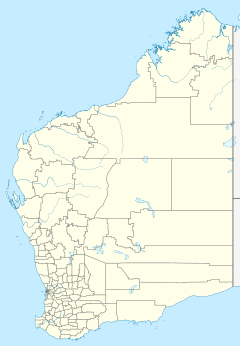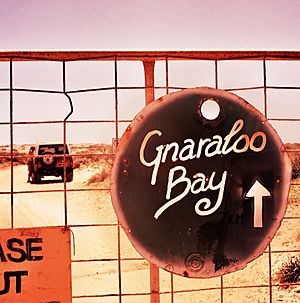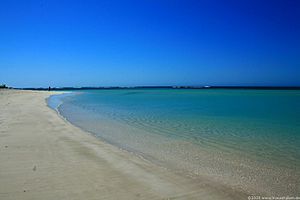Gnaraloo facts for kids
Gnaraloo is a special place in Western Australia. It's a big working farm, called a pastoral station, and also a wilderness tourism spot. You can find it in Gnaraloo Bay, which is part of the Shire of Carnarvon.
Gnaraloo is right next to the amazing Ningaloo Marine Park. It's about 150 km (93 mi) north of a town called Carnarvon. People love Gnaraloo for its beautiful coastline, cool wildlife, great fishing, and awesome waves for surfing and wind sports.
One of the most famous surf spots here is called "Tombstones." It's known for its powerful, hollow waves that break to the left.
Contents
Gnaraloo's Past: A Look at Its History
The Gnaraloo area was first settled by Donald Fleming. He worked with Arthur Nicol to claim land, and at that time, it was known as "Flemington." Donald later sold the land to Frank Mottram, but he stayed in the area until 1935.
In 1908, the station was huge, about 90,000 acres (36,422 ha). It was owned by a company called Forrest, Emanuel and Co. Frank Mottram took over in 1910. He started with about 1,500 sheep. By 1911, the flock grew to 3,554 sheep, even without buying new ones! After a good year in 1912, another 800 lambs were born, making the flock even bigger.
Changing Owners and Growing the Station
In 1921, the Mottrams sold the lease for Gnaraloo to Dansy Powell and Harry Cordes. By then, the station had 9,000 sheep and covered a massive 190,000 acres (76,890 ha). The lease was set to end in 1948.
The property was well-equipped. It had 70 km (43 mi) of fences, dividing it into 12 paddocks. There were 9 wells, and 8 of them had windmills, tanks, and troughs to provide water. The main house had three large rooms, an office, and a storage room, plus a separate stone kitchen.
In 1922, Powell and Cordes had a great year. They sheared 9,000 sheep and produced 223 bales of wool. All the animals were in good health.
The Fleming Family Returns
Powell and Cordes sold the station again in 1927. This time, it was bought by a team-up between Alex Fleming (Donald Fleming's son) and George Baden Powell.
In 1928, the Gnaraloo Pastoral Company, which was formed by the Fleming and Powell families, was dissolved. The Fleming family then became the sole owners of the station once more. Alex Fleming owned Gnaraloo from 1928 until at least 1954. The Fleming family continued to own Gnaraloo until 1975.
More recently, in 2015, the station owners had to make a new agreement with the government. This included giving up some parts of their land along the Ningaloo Coast, which is a World Heritage site. These areas were set aside for conservation and tourism.
Gnaraloo's Landscape and Climate
Gnaraloo's main homestead is on high ground. It's about 500 m (1,640 ft) east of the coast and 16 km (10 mi) west of Lake MacLeod. The station covers about 90,000 ha (222,395 acres) and has roughly 65 km (40 mi) of coastline.
Coastal Features and Reefs
Gnaraloo Bay has four sandy beaches. These beaches are protected by a nearly continuous barrier reef. This reef is about 200 to 500 m (656 to 1,640 ft) wide and sits about 1.5 km (0.93 mi) offshore.
The main beach is Gnaraloo beach. It's about 3 km (1.9 mi) south of the homestead and stretches for about 3.4 km (2.1 mi). North of Gnaraloo Bay, just before Ningaloo, you'll find Nine Mile Bore and Cape Farquhar, each with three beaches. To the south are Red Bluff and the Quobba homestead.
Weather and Rainfall
Gnaraloo usually gets about 203 mm (8.0 in) of rainfall each year. Most of this rain falls between May and July. The area is quite dry, with about 2,800 to 3,000 mm (110 to 118 in) of water evaporating each year.
In 1953, Gnaraloo had very heavy rains. It received 155 mm (6.1 in) of rain in just two days! Other nearby stations also got a lot of rain, up to 76 mm (3.0 in).
Getting to Gnaraloo
You can reach Gnaraloo by driving from Carnarvon along the Gnaraloo road. There's also a small airstrip just outside the leased area. However, there are no regular flights. In 2008, there were plans to improve the airstrip to make it easier for the Royal Flying Doctor Service to land there.
Protecting Gnaraloo's Wildlife
Gnaraloo station is very active in protecting its natural environment.
Gnaraloo Turtle Conservation Program
In 2008, Gnaraloo started its turtle conservation program. This program works with the WA Department of Environment and Conservation (DEC). The Gnaraloo Turtle Conservation Program (GTCP) involves daily patrols during the entire loggerhead turtle nesting season, which runs from November to February. These patrols help protect the turtle nests.
Controlling Feral Animals
A program to control feral animals was started in 2009. This program works hand-in-hand with the sea turtle conservation efforts. Introduced animals, like foxes or cats, can be a big danger to sea turtle nests. This program helps keep the nests safe from predators.
Awards and Future Concerns
In 2010, the station won an award in the Keep Australia Beautiful's Clean Beach Awards. They won for their great work in protecting the plants and animals in the area, especially the Critically Endangered sea turtles that nest there.
Gnaraloo borders a UNESCO World Heritage site. In 2021, some people raised concerns about plans to build wind turbines and solar panels on the site. They worried about the possible impact on the environment.




